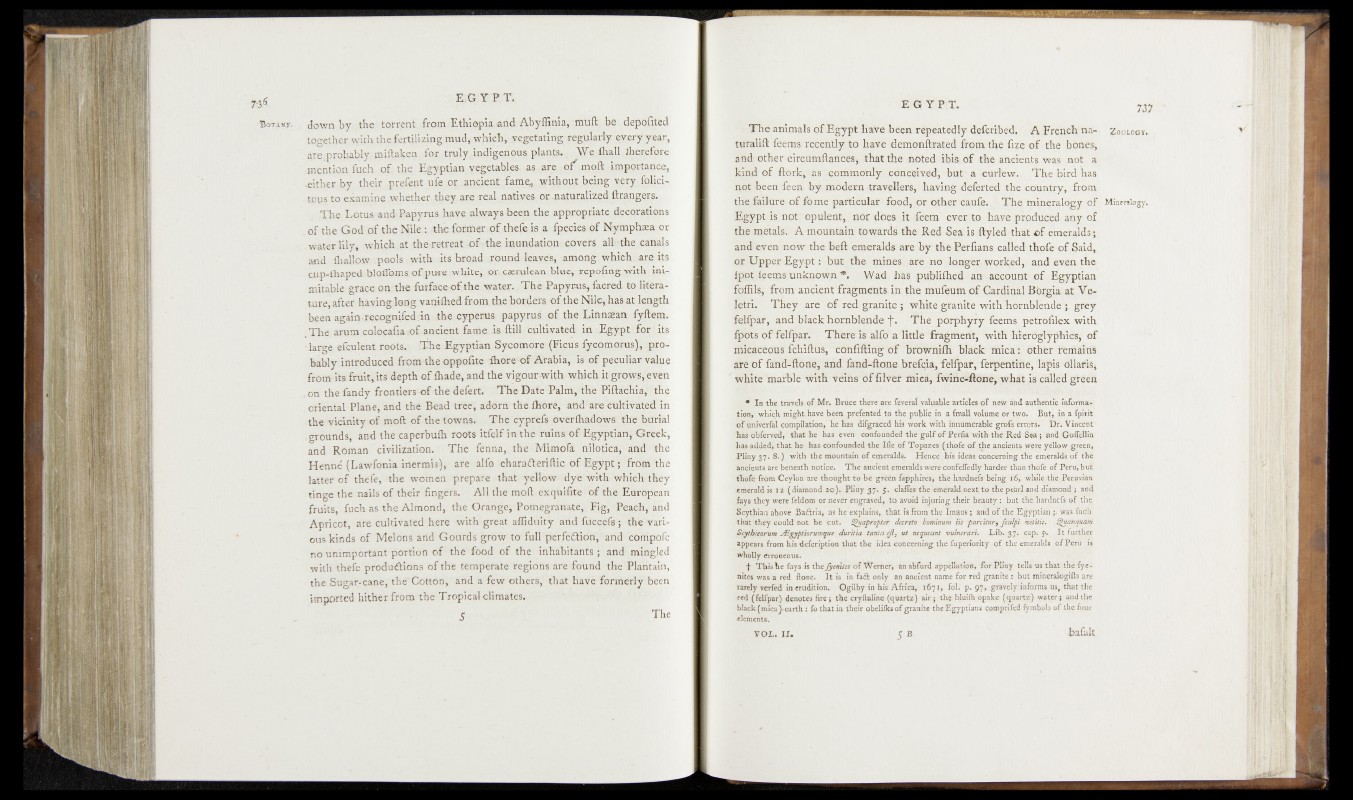
down bythe .torrent from Etbmpia.and Abyffinia, mu ft .be, depofitcd
togethervyith the fertUizingmud^whifft, ^egetatiag-fegularly'^pry'year,
•Sïe^prx^Wy-fnifta^eïiA for truly .indigenous plants. ^ ^ e&£halL.^i^tfp're
mention fuch of the Egyptian vegetables, as.are of moft5:hxy^tance,
.either- by their prefent uf©,or ancient fame;, witl^ufLeing yery^fplici-
;tpBa to e^mbe .whether they, are real natives or ^ a t^ i^ d jBligJxg(ejs.
■ The Lotus and. Papyrus have always been the appropriate d‘eeQYa|ions
of the God of the Nile: thé former of thefe. is a fpecies.of Nymphaea or
, water hlf, which at inundation. covers aH&fchft canals
aod (hallow póófe -with,Its hroajLjouad leaves* among.mbifch;.ar^its
caip-fhaped bloflbmsof pure .white, pr. eseruiean blue, repofrijg-yyith |pi-
mitable grace on the furface-of the water. The Papyrus, facred tc^lMera-
ture, after having long vanifhed from the borders of the Nile, has at length
been again • recognifed -:in the. cyperys papyrus; ,of. the Linnsean; fyftem.
The.aram colefafiajpfiancient famfijskdlillrcykiyated ip- %#pt, 6 o |p
■ large efculent roots- The Egyptian Sycomore-(Ficus. %comd.sus^ ipro-
bably introduced fromthe oppofite fhore-of Arabia, is of peculiar Mlue
from-ks fruit,its depth of lhade, and the vigour-wifh which.ii<gróws'£e ven
■ op the fandy frontiets-of the defert. The DaÊe Talm, the -Pl'ftdchi^ithe
Oriental Plane, arid-the-Bead tree, adorn th&ihère, and ^recultivated in
the vicinity of moft of the towns. The cyprefs ovërfhadows thedsiMal
.founds, and the;eaperbufh roots itfelf in-the ftiios óf Egyptian )
and Roman civilization. The fSöfta, the Miaiola hdfeticaj-a'hd’-Tthe
Henne (Lawfonia inerrais), are alfa eh ara&eri ftic - of- -Egypt : fro hi Hie
latter of thefe, the women prepare that-yellow d-yë with- which' they
tinge the nails of their fingps- All the molhexquiSfe* óf the Etirbpean
fruits, fuch as the Almond, the Orange, Pomegranate,. Fig, Peach, and
Apricot, are cultivated here with great affiduity and fuccefs; the various
kinds of Melons and Gourds grow to full perfection, and compofe
no unimportant portion of the food of the inhabitants ; and mingled
with thefe productions of the temperate regions are found the Plantain,
the.Sugar-cane, thé"Cotton, and a few others, that have formerly been,
imported hither from the Tropical climates.
5 The
Thóanimais dfiBgypt -haVe been repeatedly defcribed. A French na-
turalift feeius’ recenftly to ha^è fdemenfttatéd from the fi?e of the bones-,
and’ other• eircumft an ces* .‘that-the> noted ibis pf the ancients was not a
hind of Ifei&y-as ''commonly conceived* but - a curlew. I'he bird has
QPt’heentfeepf by njode-m travellers* haying d$fer,£ed -the country, from
the, failure of feme particular food, or other Gaufe.^ -- The mineralogy of-
Egypt is nott 'opulent-,, nor does it fe©m oyer,to have produced any of
the metals.; «A-mountain towardè the Red Sea isjftykd that-ef emeralds.;
and even now- the heft emeralds are by the Perfians called thofe of Said,
Óf-Upper Egypt: bat - the mines are no longer worked, and even the
jpot feems unknown *. Wad has publifhed-aiy account of Egyptian
föffils, frprtr ancient fragments inr the mufeum of Cardinal Bbrgia at Ve-
letri. They are of red granite; white granite withmÓÉhfeJehrtó’; grey
felfpar, and black hornblende f. The porphyry feems pet-rofilex with
ipóts of felfpar. There is hlftf a little fragment, with Merif|?f^Me§s of
ntieaceous fchiftUs, cohftfting of brownifh black mica : other hémairiS
axe of fand-ftone, and fand-ftone brefeia, felfpar, ferpèntiÖe, lapis PllatiSj
white marble with veihs öffilver mica, fwiüe*Ronié, what is called gtéèii
* In the travels of.Mr. Bruce there are feveral valuable articles o f new ahd authentic informal
tion, which might have been prefented tö the public in a finall volume or two. But, in a fpirit
o f univei&l gompifatlon, he has disgraced his wdrk With innumerable gepfè feroré.1- D ri Vitrcfetti’
has obfcrved, th at he has even confounded thé gulf of Perfia with the Red Sed ;• and OofTeHiii
has added, th at he has confounded the Me df Topazes (thofe o f the ancients were yello w green,
Pliny 37. 8 .) with the mountain o f emeralds. Hence his ideas concerning the emeralds o f thé
ancients are berieath notice. T “ e anciènt emeralds were confeffédly; harder than fhdfe o f Fifu.'fetfi:
thofe from Ceylon are thought to be green fapphires, the hardnefs being 16, While .the Peruvian
emerald is 12 (diamond 20). Pliny 37. $ . claffes the emerald next to the pearl and diamond; and
lays they were feldom or never engraved, to avoid injuring their beauty: but the hardnefs of the
Scythian above Baftria, as he explains, that is from the Imaus; and of the Egyptian was flich/
that they coiild not he cut. Quapropier decrèto hominum at parcitur, Joalpl velilit. S>uanqüani
Scythicorum JEgypiiorunique duritia tanta ejl. ut nequeant vulnerari. Lib. 37. cap. p. It further
appears from his description that the idea concerning the Superiority of the emeralds of Peru is
wholly Erroneous.
f This he fays is the fyemles of Werner,- an abfurd appellation, for Pliny tells us that the fye-
nites was a red done. I t is in faft only an ancient name for red granite :• but mineralogifts are
rarely verfed in erudition. Ogilby in his Africa, 1671, fol. p. 97, gravely informs us, that the
red (felfpar) denotes fire; the cryftaline (quartz) air; the hluifli opake (quarto) water; and the
black (mica).earth: fo that in their obelilksof granite the Egyptians cqmprifed fymbols of the four
dements.
5 »
Z oology.
Mineralogy,
VO L . I I . bafiilt